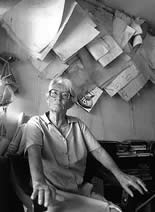Fembio Specials Famous Lesbians Maria Reiche
Fembio Special: Famous Lesbians
Maria Reiche

(Maria Reiche Grosse-Neumann)
born on May 15, 1903, in Dresden, the German Empire
died on June 8, 1998, in Lima, Peru
German mathematician, natural scientist
Biography
We drove through the (Peruvian) desert toward a small truck. A gray-haired lady jumped out of the driver's cab. Could this gaunt woman, tanned brown like a hazelnut, be the one who, according to Lima gossip, walked naked across the desert? (Tony Morrison, 1988)
Why not! After all, she had been crossing the pampas alone for over 40 years – always in rubber sandals, because sturdy shoes would have left marks on the centuries-old “geographical” work of art that she explored and successfully campaigned to have protected. In 1994, UNESCO declared the lines and ground drawings of Nazca a World Heritage Site. They stretch for miles across the pampas, straight as an arrow – sometimes over hills, sometimes forming gigantic trapezoidal areas, geometric figures, or animal images. Many of them are only visible from the air due to their size.
When the lines were discovered in 1926, Reiche was studying mathematics, physics, philosophy, geography, and education in Hamburg to become a teacher. She left Germany in 1932:
The thought of all the hatred that was being generated disgusted me.
She worked in Peru as a private tutor and translator before meeting the American scientist Professor Paul Kosok. He had been researching ancient irrigation systems in the Nazca region. Before returning to the United States, he asked Reiche to take some measurements of the strangely straight lines that he believed to be a kind of calendar for sowing and harvesting times. She was paid $15 for her work.
That was how she began unraveling the origin and meaning of the lines. She suspected that they contained the astronomical knowledge of Nazca scholars in an encrypted form. She measured and mapped them to determine their “historical unit of measurement.” She did most of this on foot, often poorly nourished, living in a room in a farm worker's house without water or electricity on the edge of the pampas. At night, mice would eat the notes she had taken. For years, she carefully swept the rubble-covered lines with a broom to make them more visible. The Peruvian Air Force's national aerial photography service allowed her to fly with them, even sometimes strapped to the skids of a helicopter so she could hold the camera vertically. Reiche's aerial photographs made her world famous. She gave lectures in Munich and London to draw the public’s attention to the threat of destruction.
The mysterious images in the desert inspired scientists, amateur researchers, and speculators to come up with ever new theories about the purpose of the site. More and more tourists visited the desert with its giant images. Reiche rightly feared that the lines could be destroyed.
“The hotels in Nazca are filling up with people who come to see (and trample) the pampa, yet no one wants to do anything to preserve it,” she wrote in a letter to her mother. “The many car tracks on the pampa hurt me. The spider is completely trampled. I am now going to get the president to fly over the pampa in a helicopter so that he can finally see for himself the need to place it under protection.”
With the proceeds from her books and the support of her companion Amy Meredith, Reiche financed security guards and later, together with her sister Renate, the construction of a viewing tower on the Pan-American Highway. After a long struggle, she succeeded in 1978 in having the Nazca area and its geoglyphs placed under protection by the Peruvian government and access prohibited. In 1994, UNESCO declared the lines and ground drawings a World Heritage Site. Peru honored Maria Reiche's services to its culture and this unique monument with honorary doctorates, citizenship, and free room and board at the Hotel Los Turistas in Nazca when she retired.
Authors: Mechthild Winkler-Jordan and Viola Zetzsche
(Text from 2002; translated with DeepL.com; edited by Ramona Fararo, 2025.
Please consult the German version for additional information, pictures, sources, videos, and bibliography.)
Quotes
Nazca is the land of eternal sunshine, and I see before me the wide horizons of the pampa, spreading out in brownish red in the summer sun, lonely and mysterious, without a trace of animal or plant life, let alone humans, with the curved lines of the reddish-purple mountains on the northeastern horizon, where the Andes rise with intertwined mountain ranges and their distant peaks. For many, the region is too barren and desolate, but for me these are my lands, and I feel at one with the wide sky, the dark stony ground, and the vast plain on which a human being is lost like a tiny invisible dot far away. When I work, I don't feel hunger or thirst or my own aging. (Maria Reiche)
I mean, I had a permanent vacation under an eternally blue sky… What a pleasure it was when I drew on my sketchpad. Once, I was actually planning to draw a frog, but in the end, it was a monkey that emerged – how I laughed! (Maria Reiche)
If you hold the rights to one or more of the images on this page and object to its/their appearance here, please contact Fembio.


